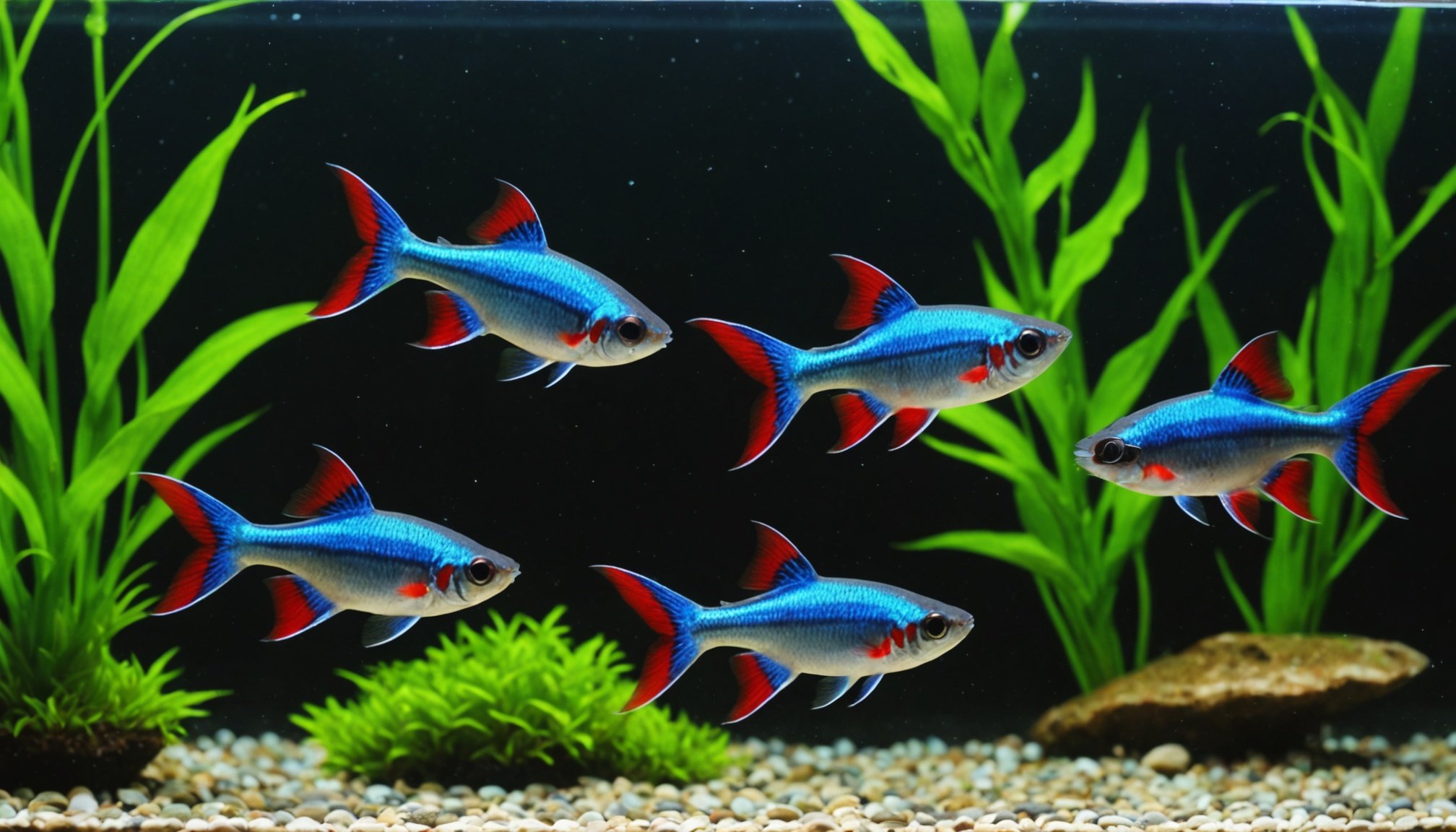Optimal Water Conditions for Successfully Breeding Neon Tetras in Your Home Aquarium
Breeding neon tetras can be a fascinating and rewarding experience for any aquarium enthusiast. However, it requires a deep understanding of the specific water conditions these tiny fish need to thrive. Here’s a comprehensive guide to help you create the perfect environment for breeding neon tetras in your home aquarium.
Understanding the Natural Habitat of Neon Tetras
To breed neon tetras successfully, it's crucial to replicate their natural habitat as closely as possible. Neon tetras, scientifically known as Paracheirodon innesi, are native to the freshwaters of South America, particularly in the blackwater streams and rivers of Brazil, Colombia, and Peru.
A découvrir également : Mastering Wildlife Encounters: A Guide to Safely Training Your Cockapoo in UK Parks
Water Parameters in the Wild
In their natural habitat, neon tetras live in waters characterized by:
- Low pH levels, typically between 6.0 and 7.0.
- Soft water with nearly zero hardness.
- Temperatures ranging from 21 to 24°C (70 to 75°F).
Setting Up the Breeding Tank
Creating a breeding tank that mimics these conditions is essential for the health and fertility of your neon tetras.
Cela peut vous intéresser : Mastering Raw Diets: A Complete Guide to Balanced Nutrition for Your Ferret
Tank Setup and Equipment
Here are the key components you need for your breeding tank:
Tubs and Containers: Use small tubs or containers, approximately 4 liters each, to create separate breeding environments. These tubs should have clear sections for observation and opaque sides to prevent the fish from seeing each other.
Substrate: Cocoa fiber is an ideal substrate for breeding neon tetras. It provides a safe surface for egg-laying and prevents the fish from eating their eggs.
Water: Use Reverse Osmosis (RO) water or rainwater to fill the breeding tubs. This water should have a pH around 6.2 to 6.3 and Total Dissolved Solids (TDS) as low as possible, ideally around 40 ppm.
Temperature: Maintain a temperature between 21 to 22°C (70 to 72°F) for optimal breeding conditions. If your main tank is warmer, consider moving the breeding tubs to a cooler room.
Example of a Breeding Tank Setup
| Component | Description |
|---|---|
| Tubs | Small, 4-liter tubs with clear and opaque sections |
| Substrate | Cocoa fiber |
| Water | RO or rainwater with pH 6.2-6.3 and TDS around 40 ppm |
| Temperature | 21-22°C (70-72°F) |
| Lighting | Dim or no lighting to protect photosensitive eggs |
| Filtration | Minimal filtration to avoid disturbing the eggs and fry |
Maintaining Optimal Water Parameters
Maintaining stable and optimal water parameters is crucial for the health and success of your breeding program.
pH Levels
Neon tetras thrive in slightly acidic to neutral water, with a pH range of 6.0 to 7.0. Any significant deviation from this range can stress the fish and reduce their fertility.
Water Hardness
Soft water is essential for neon tetras. Use RO water or rainwater to ensure the water hardness is as low as possible. This mimics their natural habitat and helps in successful spawning.
Temperature Stability
Temperature stability is vital. Keep the temperature consistent between 21 to 22°C (70 to 72°F). Avoid sudden changes, as they can stress the fish and affect egg viability.
Water Changes
Regular water changes are critical to maintain water quality. Perform partial water changes (about 10-20% every week) to prevent the buildup of waste and pollutants. This ensures the water remains clean and stable for the fish and their eggs.
Conditioning the Fish for Breeding
Before you start breeding, it's essential to condition your neon tetras to ensure they are healthy and fertile.
Diet and Nutrition
Feed your neon tetras a varied and nutritious diet that includes high-quality foods such as baby brine shrimp, live black worms, and other small invertebrates. This conditioning helps the females produce healthy eggs and makes it easier to differentiate between males and females.
Identifying Males and Females
Identifying the right pairs is crucial for successful breeding. Here’s what to look for:
- Males: Have a straight neon line and are generally more slender.
- Females: Have a slightly bent neon line and are plumper.
The Breeding Process
Once your tank is set up and your fish are conditioned, you can proceed with the breeding process.
Setting Up the Breeding Tubs
Fill the breeding tubs with RO or rainwater, and add a layer of washed cocoa fiber at the bottom. Carefully add one pair of neon tetras to each tub. Cover the tubs to keep the environment dark and prevent the tetras from jumping out.
Monitoring the Spawning
Turn off any lights in the breeding room and leave the tubs covered. Check the tubs the next morning for signs of spawning. Neon tetra eggs are photosensitive, so protect them from light. You can temporarily expose them but avoid prolonged light exposure.
Care for the Eggs and Fry
After spawning, the care of the eggs and fry is critical for their survival.
Egg Care
- Keep the environment dark to protect the photosensitive eggs.
- Avoid any significant water changes during the first few days to prevent disturbing the eggs.
- After 24 hours, you can start checking for fertilized eggs. Fertilized eggs will be transparent, while unfertilized eggs will turn white.
Fry Care
- After 24-36 hours, the eggs will hatch. The fry will be very small and delicate.
- Start feeding the fry with newly hatched Artemia salina (brine shrimp) after 7 days.
- Transfer the fry to a larger tank (around 50 liters) after 10 days to give them space to grow.
- Ensure the water quality remains high by performing regular water changes and maintaining optimal water parameters.
Troubleshooting Common Issues
Breeding neon tetras can come with some challenges. Here are some common issues and how to address them:
Infertility
- Ensure you’re using correctly identified males and females.
- Conditioning the fish properly is crucial. Give them time to cycle through their eggs by continually rotating pairs.
- Persistence is key; keep rotating new pairs into the breeding tubs until you see successful fertilized eggs.
Poor Water Quality
- Cleanliness is paramount. Regular water changes are essential to prevent the buildup of waste and pollutants.
- Inadequate water quality can lead to high fry mortality. Monitor water parameters closely and make adjustments as necessary.
Light Sensitivity
- Neon tetra eggs and fry are photosensitive. Ensure that their environment remains dark, especially during the critical early stages.
- Use dim or filtered lighting to protect the eggs and fry from excessive light exposure.
Practical Tips and Insights
Here are some practical tips to help you succeed in breeding neon tetras:
- Stability is Key: Maintain stable water parameters and avoid sudden changes in temperature, pH, or water hardness.
- Monitor Water Quality: Regular water changes and monitoring of water parameters are crucial for the health of the fish and their eggs.
- Patience is Essential: Breeding neon tetras can be a slow and sometimes frustrating process. Be patient and persistent, as it may take several attempts to achieve successful spawns.
- Keep it Simple: Avoid over-complicating the breeding setup. Simple, well-maintained tanks often yield better results than complex setups.
Breeding neon tetras is a rewarding experience that requires careful attention to detail and a deep understanding of their specific needs. By replicating their natural habitat, conditioning the fish properly, and maintaining optimal water parameters, you can increase your chances of successful breeding.
As one experienced aquarist noted, "The key to breeding neon tetras is to create an environment that is as close to their natural habitat as possible. This includes maintaining stable water parameters, providing the right diet, and ensuring the tank is free from stressors."
By following these guidelines and tips, you can successfully breed neon tetras in your home aquarium and enjoy the beauty and fascination of these incredible fish.











